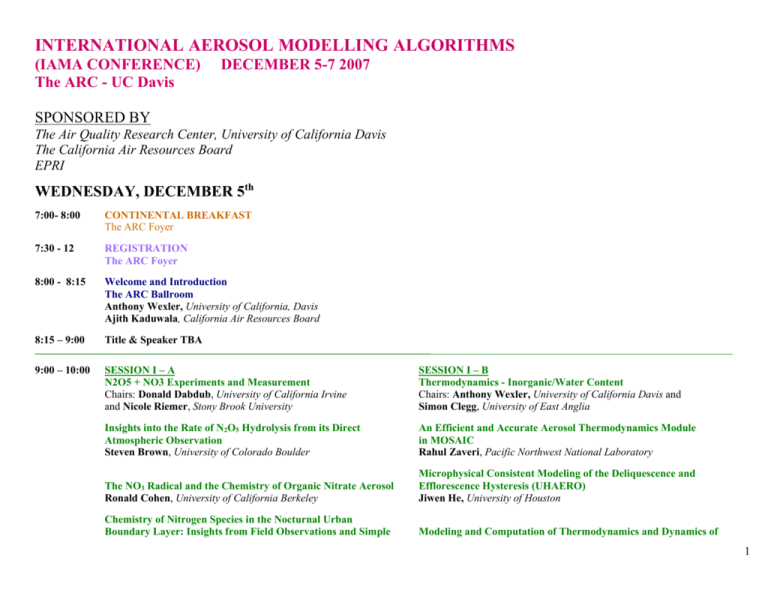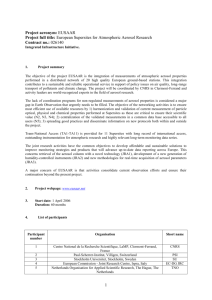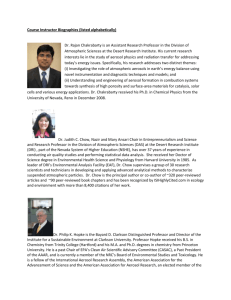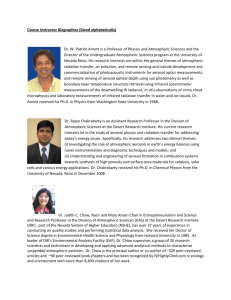IAMAdraft
advertisement

INTERNATIONAL AEROSOL MODELLING ALGORITHMS (IAMA CONFERENCE) The ARC - UC Davis DECEMBER 5-7 2007 SPONSORED BY The Air Quality Research Center, University of California Davis The California Air Resources Board EPRI WEDNESDAY, DECEMBER 5th 7:00- 8:00 CONTINENTAL BREAKFAST The ARC Foyer 7:30 - 12 REGISTRATION The ARC Foyer 8:00 - 8:15 Welcome and Introduction The ARC Ballroom Anthony Wexler, University of California, Davis Ajith Kaduwala, California Air Resources Board 8:15 – 9:00 Title & Speaker TBA ______________________________________________________________________________________________________ 9:00 – 10:00 SESSION I – A N2O5 + NO3 Experiments and Measurement Chairs: Donald Dabdub, University of California Irvine and Nicole Riemer, Stony Brook University SESSION I – B Thermodynamics - Inorganic/Water Content Chairs: Anthony Wexler, University of California Davis and Simon Clegg, University of East Anglia Insights into the Rate of N2O5 Hydrolysis from its Direct Atmospheric Observation Steven Brown, University of Colorado Boulder An Efficient and Accurate Aerosol Thermodynamics Module in MOSAIC Rahul Zaveri, Pacific Northwest National Laboratory The NO3 Radical and the Chemistry of Organic Nitrate Aerosol Ronald Cohen, University of California Berkeley Microphysical Consistent Modeling of the Deliquescence and Efflorescence Hysteresis (UHAERO) Jiwen He, University of Houston Chemistry of Nitrogen Species in the Nocturnal Urban Boundary Layer: Insights from Field Observations and Simple Modeling and Computation of Thermodynamics and Dynamics of 1 Module Calculations Jochen Stutz, University of California Los Angeles Organic Aerosol Particles Alexandre Caboussat, University of Houston _________________________________________________________________________________________________________ 10:00 – 10:30 BREAK _________________________________________________________________________________________________________ 10:30 – 12:00 SESSION II – A N2O5 + NO3 – Modeling Chairs: Donald Dabdub, University of California Irvine and Nicole Riemer, Stony Brook University SESSION II – B Thermodynamics – Inorganics Continued Chairs: Tony Wexler, University of California Davis and Simon Clegg, University of East Anglia Modeling and Numerical Issues Related to N2O5 Dynamics Donald Dabdub, University of California Irvine Quick, Dirty and Cheap Inorganic Aerosol Thermodynamics K. Max Zhang, Cornell University The Heterogeneous Hydrolysis of N2O5: Chemistry Versus Meteorology Nicole Riemer, Stony Brook University Aerosol Thermodynamics of Potassium Salts and Water Content Near the Eutectic James Kelly, Environmental Protection Agency A Comprehensive Parametrization of the Heterogeneous Reaction Probability of N2O5 on Particles Containing Ammonium, Sulfate, and Nitrate Prakash Bhave, National Oceanic and Atmospheric Administration Estimation of Gas/Particle Partitioning in Systems Containing Multiple Inorganic and Organic Compounds: The Extended Aerosol Inorganics Model Simon Clegg, University of East Anglia A New Aerosol Model for Chemical Transport Models (CTMs): Modeling the Effects of Heterogeneous Chemistry on Atmospheric Chemistry Chao Wei and Gregory R. Carmichael, University of Iowa Overview of the ISORROPIA Thermodynamic Model Thanos Nenes, Georgia Tech __________________________________________________________________________________ _____________ 12:00 – 1:30 _ LUNCH _______________________________________________________ 1:30 – 3:00 SESSION III – A SESSION III - B Cloud/Fog Processing Eladio Kipping, EPRI and Thanos Nenes, Georgia Tech Thermodynamics – Organics Chairs: Tony Wexler, University of California Davis and Simon Clegg, University of East Anglia Physically-Based Parameterization of Cloud Droplet Formation Thanos Nenes, Georgia Tech Title TBA Constraining the Effect of Aerosol Composition on Cloud Formation Markus Petters, Colorado State University Next Steps in the Thermodynamic Modeling of Gas/Particle Partitioning of Organic Compounds in the Atmosphere Neil M. Donahue, Carnegie Mellon University James Pankow, Oregon Health & Science University 2 Constraining the Effects of Composition and Mixing State on CCN Activity, Droplet Growth Kinetics and Aerosol Indirect Effects Thanos Nenes, Georgia Tech A Thermodynamic Aerosol Module for a Non-Ideal, Phase-Separating Mixture of Primary and Secondary Organic Compounds Betty Pun, Atmospheric and Environmental Research, Inc. Sensitivity of Cloud Microphysical Properties to Cloud Nucleation Processes Surabi Menon, Lawrence Berkeley National Laboratory _____________________________________________________________________________________________________________________________ _____________________ 3:00 – 3:30 BREAK _______________________________________________________________________________________________ 3:30 – 5:00 SESSION IV - A Model: Plume in Grid Chair: Eladio Knipping, EPRI, and Prakash Karamchandani Atmospheric & Environmental Research, Inc. SESSION IV – B Secondary Organics – Global Scale Chairs: Prakash Bhave, National Oceanic and Atmospheric Administration and David Simpson, Norwegian Meteorological Institute Prakash Karamchandani,. Atmospheric & Environmental Research, Inc Modeling Secondary Organic Aerosols: Current Achievements and Future Challenges Kostas Tsigaridis, Laboratoire des Sciences du Climat et de l’Environnement (LSCE) Use of Hybrid Plume/Grid Modeling and Super Site Data to Model PM2.5 in St. Louis Ralph Morris, ENVIRON Global Modeling of Secondary Organic Aerosol Formation from Aromatic Hydrocarbons: High- vs. Low-Yield Pathways Daven Henze, Caltech Title TBA Modeling the Impact of Aerosol Formation to Particle and CCN Concentrations on Regional and Global Scales Tatu Anttila, Finnish Meteorological Institute Plume-in-Grid Modeling for PM - A Parallel Approach Irene Korsakissok, Centre d’Enseignement et de Recherche en Environnement Atmospherique _______________________________________________________________________________________ 5:00 – 7:00 WELCOMING RECEPTION ___________________________________________________________________________________________________________________________________________________________________________________ THURSDAY, DECEMBER 6th _________________________________________________________________________________________________________ 7:30 - 8:15 BREAKFAST The ARC Foyer 8:15 – 10:00 SESSION V- A SESSION V – B 3 Model Structure: Sections, Modes, Moments Chairs: Rahul Zaveri, Pacific Northwest National Laboratory Karine Sartelet, CEREA Secondary Organics – Regional Scale Chairs: Prakash Bhave, National Oceanic and Atmospheric Administration and David Simpson, Norwegian Meteorological Institute Variable Moment General Dynamic Equations for Global and Regional Aerosol Modeling Boris Grits, University of California Davis Modeling Carbonaceous Aerosol in Europe: Comparisons with Measurements David Simpson, Norwegian Meteorological Institute The Sectional and Modal Aerosol Models SIREAM and MAM in the Air Quality Platform Polyphemus: Common Features and Differences Karine Sartelet, CEREA Modeling the Contribution of SOA in Australian Air Pollution Events from Smog Chamber to Airshed Martin Cope, CSIRO Application of Moment-Sectional Algorithms to Emerging Problems in Aerosol Science Peter Adams, Carnegie Mellon University Evaluation of New Approaches to Modeling Atmospheric Organic Particulate Matter in CAMx Bonyoung Koo, ENVIRON International Corporation New Developments in the Quadrature Method of Moments (QMOM) Approach to Aerosol Simulation Robert McGraw, Brookhaven National Laboratory Modeling of Carbonaceous Aerosols with CHIMERE – Focus on Secondary Organic Aerosols Bertrand Bessagnet, L'Institut National de l'Environnement Industriel et des Risques A Mode Merging Algorithm for Modal Models Evan Whitby, Chimera Technologies, Inc. ___________________________________________ 10:00 – 10:30 BREAK ______________________________ 10:30 – 12:00 SESSION VI – A Model Structure: Hybrid and Fully Dynamic Chairs: Rahul Zaveri, Pacific Northwest National Laboratory Karine Sartelet, CEREA Equilibrium, Dynamic, and Hybrid Approaches for Atmospheric Aerosol Modeling Bonyoung Koo, ENVIRON Dynamic Gas-Particle Partitioning in the UCD Aerosol Module _ SESSION VI – B Secondary Organics – Kinetics Chairs: Prakash Bhave, National Oceanic and Atmospheric Administration and David Simpson, Norwegian Meteorological Institute The Rise and Fall of Organic Aerosol Mass: Oxidation Giveth and Oxidation Taketh Away Neil M. Donahue, Carnegie Mellon University Max Zhang, Cornell University Explicit Modelling of the SOA/VOC/NOx System Bernard Aumont, Universite de Paris A Solution to the Problem of Nonequilibrium Acid/Base Development of a Secondary Organic Aerosol Formation Mechanism: Comparison with Smog Chamber Experiments and Atmospheric 4 Gas-Particle Transfer at Long Time Step Mark Z. Jacobson, Stanford University Measurements Luis Olcese, University of Michigan An Efficient Algorithm for Dynamic Gas-Particle Partitioning In MOSAIC Rahul Zaveri, Pacific Northwest National Laboratory Validation of Soot Aging Models with Particle-Resolved Simulations Nicole Riemer, Stony Brook University _____________________ 12:00 – 1:30 _____ LUNCH ______________________________________________________________________________________________________ 1:30 – 3:00 SESSION VII – A Parallel Processing Issues Chairs: Mike Kleeman, University of California Davis and Donald Dabdub, University of California Irvine SESSION VII – B Secondary Organics – Miscellaneous Processes Chairs: Prakash Bhave, National Oceanic and Atmospheric Administration and David Simpson, Norwegian Meteorological Institute Efficient Parallel Methods for the Advection of Large Numbers of Species in Air Quality Models Mike Kleeman, University of California Davis SOA Model by Partitioning and Heterogeneous Reactions in the Presence of Inorganic Species Myoseon Jang, University of Florida Donald Dabdub, University of California Irvine Organic Aerosols in the Air Quality Platform Polyphemus: Oxidation Pathways, Hydrophilic/Hydrophobic Partitioning and Oligomerization Edouard Debry, CEREA A Parallel Program Building Block David Wong, National Oceanic and Atmospheric Administration The Lumped Composition Aerosol (LCA) Module for Simulating Composition Effects on SOA Formation Frank Bowman, University of North Dakota Title TBA Three Types of Secondary Organic Aerosol Yields Based on the Gas/Aerosol Partitioning Theory and Their Relevance to Modelling Organic Aerosol Formation Weimin Jiang, National Research Council of Canada ____________________________________________________________________________________________________________________________________________________________________________________ 3:00 – 3:30 BREAK ____ 3:30 – 5:00 SESSION VIII - A WRF- Chem + Aerosols Chair: Georg Grell, National Oceanic and Atmospheric Administration SESSION VIII - B Secondary Organics – In-Cloud Formation Chairs: Prakash Bhave, National Oceanic and Atmospheric Administration and David Simpson, Norwegian Meteorological Institute Overview of WRF-Chem CMAQ Parameterization of Cloud-Produced Secondary Organic Aerosol 5 Georg Grell, National Oceanic and Atmospheric Administration Ann Marie Carlton, National Oceanic and Atmospheric Administration Implementation of Aerosol-Radiation-Cloud-Chemistry Interactions in WRF-Chem Bill Gustafson, Pacific Northwest National Laboratory Simulating Secondary Organic Aerosol Formation from Cloud Processng of Organic Compounds in CMAQ-MADRID Jianjun Chen, University of California Davis [Abstract #12] Comparison of Real Time PM 2.5 Forecast Model Results with Aircraft Data from TexAQS-2006 Field Study Stuart McKeen , National Oceanic and Atmospheric Administration Chemical Processes in Cloud Droplets as Source of Secondary Organic Aerosol Barbara Ervens, National Oceanographic and Atmospheric Administration The Aerosol Modeling Test Bed: A Proposed Tool to Facilitate Improved Aerosol Process Models Jerome Fast, Pacific Northwest National Laboratory ___________________________________________________________________________________________________ FRIDAY, DECEMBER 7th ____________________________________________________________________________________________________ 7:45- 8:30 CONTINENTAL BREAKFAST The ARC Foyer 8:30 – 10:00 SESSION IX - A WRF- Chem + Aerosols CONTINUED Chair: Georg Grell, National Oceanic and Atmospheric Administration SESSION IX – B Source Oriented Chairs: Mike Kleeman, University of California Davis and Ted Russell, Georgia Tech Sensitivity Tests of CCN-Cloud Droplet Number Using a Newly Developed WRF Microphysics Scheme on Various Case Studies Greg Thompson, National Center for Atmospheric Research Regional Source Apportionment of Airborne Particulate Matter In Central California Using a Source-Oriented Air Quality Model Qi Ying, Texas A&M Inter-comparison of Forecasted Aerosol Formation by CMAQ and WRF-Chem William R. Stockwell, Howard University Primary Source Apportionment Antony Chen, Desert Research Institute Current and Future Aerosol Studies Using WRF-Chem Mary Barth, The National Center for Atmospheric Research TITLE TBA Sergey Napelenok, National Oceanic and Atmospheric Administration Dan Cohan, Rice University Developing Data Assimilation Capabilities in WRF-Chem Greg Carmichael, University of Iowa TITLE TBA (invited) Karla Longo, Centro de Previsão de Tempo e Estudos Climáticos 6 10:00 – 10:15 BREAK 10:15 – 12:00 WRAP-UP AND NEXT STEPS Anthony Wexler, University of California, Davis Ajith Kaduwala, California Air Resources Board POSTERS 1 - The Importance of Aerosol Water for Air Pollution Effects on Weather and Climate - A New Concept S. Metzger, Max Planck Institute for Chemistry 2 - Statistics of Volumes, Swept by Non- Spherical Particles in a Turbulent Flow B. Grits, M. Pinsky and A. Khain, The Hebrew University of Jerusalem, Israel 3 - Comparison of CMAQ Aerosol Predictions by Two Thermodynamic Modules: UHAERO vs. ISORROPIA Fang-Yi Cheng, Andrey Martynenko, Daewon Byun and Jiwen He, University of Houston 4 - Developing Sectional Aerosol Models for Modelling UK Atmospheric Aerosol Michael K. Bane, Douglas Lowe & Gordon B. McFiggans, University of Manchester 5 - Investigation of the Influence of Microphysical Assumptions on Aerosol Chemistry Systems Douglas Lowe, David Topping, & Gordan McFiggans, University of Manchester 6 - Emissions Sensitivities for PM Components for a Rural Site in the United Kingdom Using a Photochemical Trajectory Model R.G. Derwent rdscientific 7 - Characterization of Aerosols in U.S Southwest Cities Using an Inverse Reconstruction Model to Retrieve Aerosol Size Distribution from Optical Depth Data Rosa Fitzgerald and Javier Polanco, University of Texas and William Stockwell, Howard University 7







